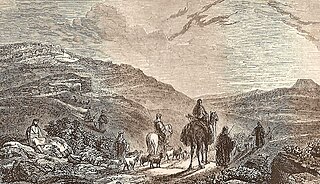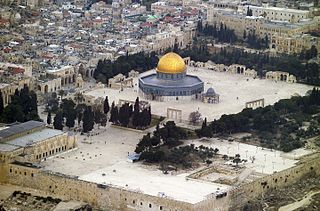Related Research Articles

Bethlehem is a city in the West Bank, Palestine, located about 10 kilometres (6.2 mi) south of Jerusalem. It is the capital of the Bethlehem Governorate, and has a population of approximately 25,000 people. The city's economy is largely tourist-driven; international tourism peaks around and during Christmas, when Christians embark on a pilgrimage to the Church of the Nativity, revered as the location of the Nativity of Jesus. At the northern entrance of the city is Rachel's Tomb, the burial place of biblical matriarch Rachel. Movement around the city is limited due to the Israeli West Bank barrier.

Amman is the capital and the largest city of Jordan, and the country's economic, political, and cultural center. With a population of 4,061,150 as of 2021, Amman is Jordan's primate city and is the largest city in the Levant region, the fifth-largest city in the Arab world, and the ninth-largest metropolitan area in the Middle East.

Al-Rifa'i Mosque is located in Citadel Square, adjacent to the Cairo Citadel. Now, it is also the royal mausoleum of Muhammad Ali's family. The building is located opposite the Mosque-Madrassa of Sultan Hassan, which dates from around 1361, and was architecturally conceived as a complement to the older structure. This was part of a vast campaign by the 19th century rulers of Egypt to both associate themselves with the perceived glory of earlier periods in Egypt's Islamic history and modernize the city. The mosque was constructed next to two large public squares and off of several European style boulevards constructed around the same time.

The Great Mosque of Samarra is a mosque from the 9th century CE located in Samarra, Iraq. The mosque was commissioned in 848 and completed in 851 by the Abbasid caliph Al-Mutawakkil who reigned from 847 until 861. At the time of construction, it was the world's largest mosque. It is known for its 52 metres (171 ft) high minaret encircled by a spiral ramp. The mosque is located within the 15,058-hectare (37,210-acre) Samarra Archaeological City UNESCO World Heritage Site, listed in 2007.

Al-Marwani Mushalla is an underground vaulted space now used as a Muslim prayer hall by the name of Al-Marwani Mosque, some 600 square yards in area, at the bottom of stairs which lead down from the al-Aqsa Mosque, under the al-Aqsa Mosque, to the base of the southern wall of the enclave of al-Aqsa Mosque in Islamicjerusalem Jerusalem. Al-Marwani Mosque is located under the southeastern corner of the al-Aqsa Mosque compound, 12.5 m (41 ft) below the courtyard, and feature twelve rows of pillars and arches. In December 1996 the Waqf converted the area into a prayer hall by adding lights and floor tiles, and renamed it the El-Marwani Prayer Hall.
Abdel-Wahed El-Wakil is an Egyptian architect who designed over 15 mosques in Saudi Arabia and is considered by many as the foremost contemporary authority in Islamic architecture. For designing in traditional styles, he is also a representative of New Classical Architecture.

The Sheikh Zayed Grand Mosque is located in Abu Dhabi, the capital city of the United Arab Emirates. The largest mosque in the country, it is the key place of worship for daily prayers. A smaller replica of the grand mosque exists in the Indonesian city of Surakarta.

Teqoa is a Palestinian town in the Bethlehem Governorate, located 12 km (7.5 mi) southeast of Bethlehem in the West Bank. The town is built adjacent to the biblical site of Tekoa (Thecoe), now Khirbet Tuqu’, from which it takes its name. Today's town includes three other localities: Khirbet Ad Deir, Al Halkoom, and Khirbet Teqoa. According to the Palestinian Central Bureau of Statistics (PCBS), Teqoa had a population of 8,881 in 2007.

The Mosque of Omar is the only mosque in the Old City of Bethlehem, Palestine. It is located on the west side of Manger Square, across the square from the Church of the Nativity.

The Amman Citadel is an archeological site at the center of downtown Amman, the capital of Jordan. The L-shaped hill is one of the seven hills (jabals) that originally made up Amman.

The Jerusalem Waqf and Al-Aqsa Mosque Affairs Department, also known as the Jerusalem Waqf, the Jordanian Waqf or simply the Waqf, is the Jordanian-appointed organization responsible for controlling and managing the current Islamic edifices on the Temple Mount in the Old City of Jerusalem, known to Muslims as the Al-Aqsa Mosque, which includes the Dome of the Rock. The Jerusalem Waqf is guided by a council composed of 18 members and headed by a director, all appointed by Jordan. The current director of the Waqf, since 2005, is Sheikh Azzam al-Khatib.

Faisal II was the last King of Iraq. He reigned from 4 April 1939 until July 1958, when he was killed during the 14 July Revolution. This regicide marked the end of the thirty-seven-year-old Hashemite monarchy in Iraq, which then became a republic.

King Hussein Bin Talal Mosque, better known as the King Hussein Mosque, is the largest mosque in Jordan. Not to be confused with the 1924 Grand Al-Husseini Mosque, also known as King Hussein Mosque, in Downtown Amman.

Hashemite custodianship refers to the Jordanian royal family's role in tending Muslim and Christian holy sites in the city of Jerusalem. The legacy traces back to 1924 when the Supreme Muslim Council, the highest Muslim body in charge of Muslim community affairs in Mandatory Palestine, chose Hussein bin Ali as custodian of Al-Aqsa. The custodianship became a Hashemite legacy administered by consecutive Jordanian kings.

Al-Fath Mosque is a mosque in the city of Cairo. Located in the Ramses Square, it is among the largest mosques and equips the tallest minaret in the city and the 3rd tallest in the world. During the post-coup unrest in Egypt, the Second Ramses Incident took place in the mosque on August 16, 2013, which resulted in the death and injury of several protesters and subsequent shut down of the mosque.

Yasser Al-Masri was a Kuwaiti-born Jordanian-Palestinian actor.

Ammar Khammash is a Jordanian architect, designer and artist. His work is based on the integration of building designs with nature and the surrounding environment. His projects helped revive Pella and Jordan Valley by creating two rest stops.
Assem Salam ; was a Lebanese civil engineer, architect and author. He graduated from the University of Cambridge in 1950. Asem used patterns and shapes from the Islamic tradition in his works.
Rami Daher is a Jordanian architect, academic, and public intellectual specializing in architectural conservation and urban design. He is currently an associate professor at the School of Architecture and Built Environment at the German Jordanian University and general director of TURATH, an architectural and urban design consultancy in Amman, which has executed several major interventions in historic and heritage settings.

On 15 April 2022, clashes erupted between Palestinians and Israeli Security Forces on the Al-Aqsa Compound in the Old City of Jerusalem. According to the United Nations Special Coordinator for the Middle East Peace Process, the clashes began when Palestinians threw stones, firecrackers, and other heavy objects at Israeli police officers. The policemen used tear gas shells, stun grenades and police batons against the Palestinians. Some Palestinians afterwards barricaded themselves inside the Al-Aqsa Mosque and proceeded to throw stones at the officers. In response, police raided the mosque, arresting those who had barricaded themselves inside. In addition, some damage was done to the mosque's structure.
References
- ↑ "فتح باب الترشح للدورة الثالثة من جائزة حسيب الصباغ وسعيد خوري للهندسة". دنيا الوطن. 23 May 2018.
- ↑ "الألمانية تحصد المركز الثاني في مسابقة كفاءة لعام 2018". جريدة الدستور الاردنية.
- ↑ "Spine Mosque". Construction Week Online Middle East.
- ↑ "Palm Jumeirah mosque has unique design". The National. 24 July 2012.
- ↑ "Renowned architect lectures at Ajman University".
- ↑ "محاضرة في جامعة عجمان حول عمارة المساجد". www.alkhaleej.ae.
- ↑ "Dr.Farouk Yaghmour". Archived from the original on 2011-08-04. Retrieved 2020-09-05.